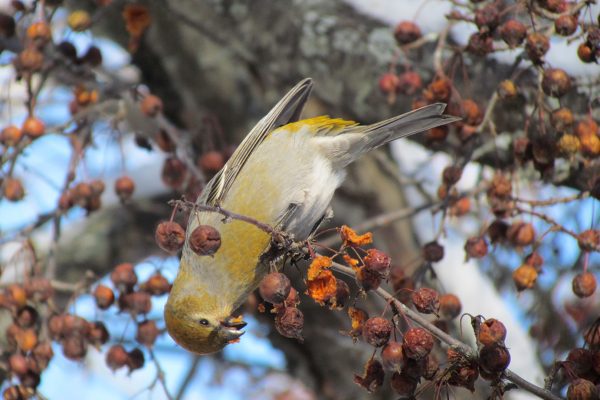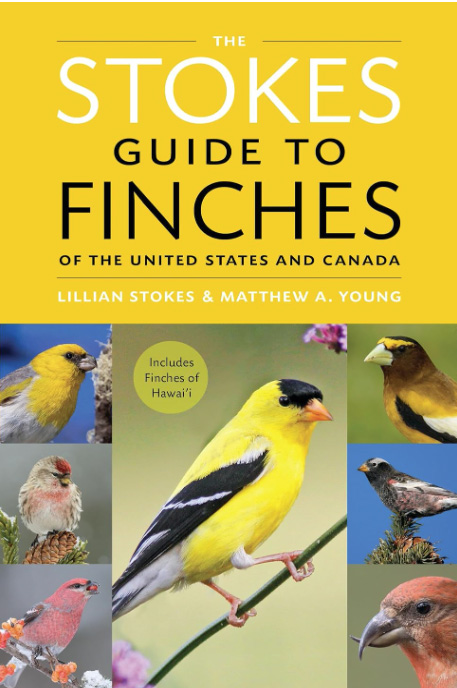
On a recent walk around their neighborhood, the authors were surprised to find an early flock of Pine Grosbeaks, one of the northern winter finch species that in some winters move south to places like Maine during the colder months. (Photo courtesy of Jeff and Allison Wells)
While walking our dog through the neighborhood recently, we heard what sounded like the soft, mellow notes of Pine Grosbeaks. We were surprised; it seemed too early for these northern finches to be showing up in Maine. But as we approached the source of the calls, there they were: six beautiful Pine Grosbeaks in the top of a tree a few blocks from our house.
We checked eBird and quickly learned that Pine Grosbeaks were showing up in a handful of backyards around the state. This got us excited about the prospect of a very finchy winter. Why the excitement?
For one thing, the most northernly breeding of the northern finches don’t show up down this way every year. Some years, they stay year-round up north. Migrants like Snow Buntings, American Tree Sparrows, Red-necked Grebes, Red-throated Loons, and Long-tailed Ducks that breed to our north are sure to come down; they spend winters here every year, no questions asked. Not so Redpolls, and Maine hosts a very few Pine Grosbeaks, Evening Grosbeaks, Pine Siskins, and White-winged Crossbills, the number that move south from Canada and Alaska some winters shows wild swings, with almost none some years and lots in other years.

One extremely early Redpoll showed up on Monhegan Island in September! (Photo by Pam Wells)
These winter swings in abundance have been shown to follow a general pattern of winter finches coming south in bigger numbers every two years. This mysterious cyclic is another reason we birders find them intriguing.
If you’re a finch fanatic like we are, we wanted to let you know about two great resources available to you. First is the Winter Finch Forecast, hosted by the Finch Research Network. It garners considerable attention when it comes out. It’s like the economic forecasts that investors eagerly await—but more fun!

Small numbers of some winter finches, like Evening Grosbeaks, breed in a very few places in Maine. During some winters, those numbers greatly expand. (Photo by David Small)
The 2025/26 forecast has predicted a good flight of winter finches into the Northeast this winter. Along with the Pine Grosbeaks, there have already been a few Redpolls here in Maine including an amazingly early one photographed on Monhegan in September. Evening Grosbeaks have been found in greater numbers across Maine already this fall; they’re one of our absolute favorite birds, so we will be especially looking and listening for them. White-winged Crossbills have been few and far between so far this fall here in Maine, but Red Crossbills seem to be in many places, especially closer to the coast. As for Pine Siskins, they seem to be widespread everywhere.
The second finch must-have is a new book co-authored by an old friend of ours from our days at the Cornell Lab of Ornithology. His name is Matt (Matthew) Young, and he has recently published, with Lillian Stokes, a book called The Stokes Guide to Finches of the United States and Canada.
You may remember Lillian Stokes from her decades of writing and publishing books on birds and other natural history subjects with her husband Don. She and Don together published 35 books in their Stokes Guides series that started some time after Don authored a couple of books himself in the late 1970s. (Jeff received a copy of Don’s A Guide to the Behavior of Common Birds as a Christmas gift from his parents in 1980!) Together, Don and Lillian went on to host several television shows on birds that inspired many people to learn more about birds and birding.

A new book about finches will make finch fanatics of all levels of enthusiasm very happy.
Matt had always been someone super interested in birds. Over the years, his interest and curiosity haveJ become particularly focused on finches. That led him to engage in various finch research projects, including how to separate the different types of Red Crossbills by their calls. Perhaps some of you may have emailed sound recordings to Matt to identify the type of Red Crossbill? Matt’s love of finches led him to start the Finch Research Network in 2020. In a way, it’s no surprise that the next step in his obsession with finches led to this wonderful new book.
The Stokes Guide to Finches of the United States and Canada is a delightful and easy-to-read book. It is beautifully designed and full of gorgeous photos. Features include Lillian’s short essays (“Quick Take”) that begin each species account; colorful maps that make sense out of the complicated ways populations of some finches ebb and flow across the continent; charts of the foods they prefer, gobs of natural history information, and a section that they charmingly title “Language,” which describes the songs and calls. There is an account for each species of finch (including also the Hawaiian honeycreepers) and also chapters on feeding and attracting finches, movements and irruptions, and research and conservation.
It’s the kind of book that you can flip through to find something that strikes your curiosity (check out the Fun Facts or the Deeper Dives), or you can sit down and read each species account and chapter from cover to cover.
Whether you’re a finch fanatic or not, you’ll love this book! Pick it up for yourself or as a gift at your local bookstore or favorite online bookseller.
—Jeff and Allison Wells











Leave a Reply